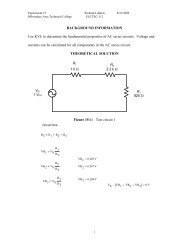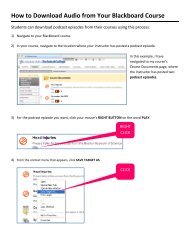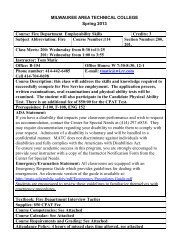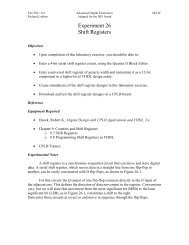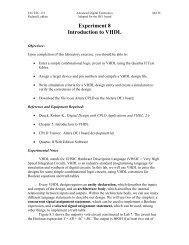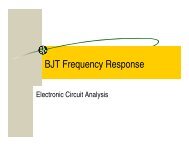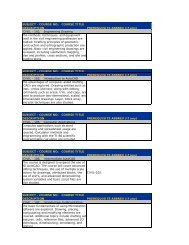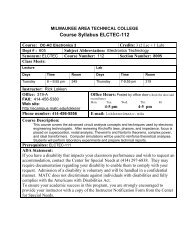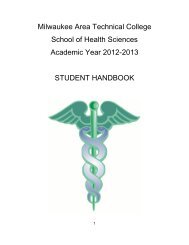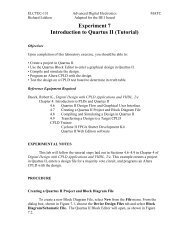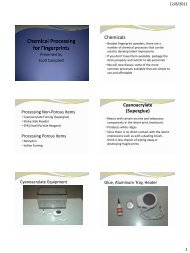Crime Scene Investigation
Crime Scene Investigation
Crime Scene Investigation
Create successful ePaper yourself
Turn your PDF publications into a flip-book with our unique Google optimized e-Paper software.
12/8/2011<br />
Stages of Processing the<br />
<strong>Crime</strong> <strong>Scene</strong> & Responsibilities<br />
The following are general guidelines and will vary<br />
depending on the seriousness and type of crime scene.<br />
Not all procedures will be used at every scene.<br />
Approach the <strong>Scene</strong><br />
• Personal safety and emergency care must come first<br />
• Check/re-check scene for suspects or other danger<br />
• Render first aid and request emergency services<br />
• Strive to preserve the scene and any possible evidence<br />
• Make others aware of evidence to minimize disruption<br />
• Make initial observations and be prepared to take control<br />
of the scene, especially if you will be processing the scene<br />
• Briefly interview first responding officer or complainant<br />
• Be alert for discarded evidence or a secondary scene<br />
• Make pertinent notes<br />
Secure and Protect the <strong>Scene</strong><br />
• Identify the boundaries of the scene and safety issues<br />
• Establish adequate security and an entry/exit point<br />
• Use personnel, police tape or barricades<br />
• Start with a larger boundary and reduce as necessary<br />
• Control and limit access to the scene to only necessary<br />
personnel<br />
• Keep out family members, neighbors, curious officers, etc<br />
• Identify and document all individuals at the scene<br />
• Victims, Witnesses, EMS, other Officers, etc<br />
• Create a crime scene entry log<br />
Secure and Protect the <strong>Scene</strong> -<br />
continued<br />
• Identify and protect transient evidence<br />
• Body fluids or footwear impressions outside from<br />
weather conditions<br />
• If a victim’s body or other evidence is moved or collected<br />
because of necessity, document it, but don’t put it back<br />
• At the scene, do not<br />
• Smoke, chew tobacco, eat, drink or spit<br />
• Use the phone, toilet or touch anything before processing<br />
• Alter anything before it’s documented and photographed<br />
Conduct a Preliminary Survey<br />
• Obtain additional details from the first responding officer<br />
or the complainant<br />
• Conduct a cautious walk-through<br />
• Determine the extent of the search area<br />
• Exterior, interior, specific rooms<br />
• Evaluate search and seizure issues<br />
• Use personal protective equipment for officer safety and<br />
to minimize contamination issues<br />
• Sanitize collection equipment or use single use items<br />
Conduct a Preliminary Survey –<br />
continued<br />
• Determine equipment and personnel needs<br />
• Photographic, DNA collection, latent processing, lighting<br />
• Specialized personnel or just extra help<br />
• Document your observations and actions<br />
• Conditions of scene and evidence such as lights on or off,<br />
door forced, lock broken, blood appeared wet/dry, etc<br />
• If it catches your attention, document it<br />
• Continue documentation as you progress through the<br />
scene and investigation<br />
• Photographs and diagrams supplement the notes but<br />
they all work together<br />
1
12/8/2011<br />
Photograph the <strong>Scene</strong><br />
• Shoot scene ASAP<br />
• As you find it before items are moved<br />
• Overall, medium, close-up (Rule of 3) of all<br />
evidence<br />
• Relate items to location & condition<br />
• Evidence both without and also<br />
with accurate scale & identifiers<br />
• Photography is inexpensive,<br />
• Video can supplement still photography<br />
Prepare a Diagram (if necessary)<br />
• Supplements your photos<br />
• Should Include<br />
• Location<br />
• Date<br />
• Case Number<br />
• Preparer’s name<br />
• Compass orientation (north)<br />
• Legend<br />
• Method of measurement<br />
• Baseline, triangulation, etc.<br />
• Indicate “Reference Points”<br />
• “Not to scale”<br />
Conduct a Detailed Search<br />
• Best search options are typically most time<br />
consuming and difficult<br />
• Choose a method that will be productive and efficient<br />
• Strip, Double Strip or Grid, Spiral, Point to Point, etc.<br />
• Two basic search approaches (in order):<br />
• Thorough search of visible/accessible areas<br />
• Cautious search of difficult/concealed areas<br />
• Remember search warrants may be necessary<br />
• Collect/process most transient evidence first<br />
Process & Collect Evidence<br />
• Photograph items PRIOR TO processing/collection<br />
• Indicate items on your sketch & evidence log<br />
• Maintain a “Chain of Custody” record<br />
• Process evidence at scene or package properly for<br />
later processing<br />
• Prevent loss of latent impressions & cross-contamination<br />
• Do not handle excessively after recovery<br />
• Wear protective gear such as gloves<br />
• Physical evidence can make or break a case<br />
• Physical evidence doesn’t lie<br />
• Juries like physical evidence<br />
Conduct a Final Survey at <strong>Scene</strong><br />
• Review all responsibilities/ tasks of the scene<br />
• Discuss findings with scene personnel/Officer in<br />
charge<br />
• Double-check documentation to avoid errors<br />
• Account for all evidence & equipment<br />
• Conduct a final walkthrough<br />
• Have you given the scene the appropriate amount of<br />
effort and attention within your time constraints?<br />
Release the <strong>Crime</strong> <strong>Scene</strong><br />
• After completion of final survey<br />
• Once released, re-entry will most likely require a<br />
search warrant<br />
• Release with the idea that there is only one chance to<br />
perform job correctly and completely<br />
• Returning at a later date can’t ensure the integrity of<br />
the scene<br />
2
12/8/2011<br />
3




